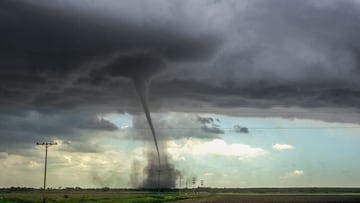How are tornadoes formed?
Severe weather has recently been battering parts of the United States, bringing about weather events like thunderstorms, which sometimes cause tornadoes.


Extreme weather has been pounding parts of the United States recently, causing downed power lines, damage to property, and even death. Storms which brought strong winds, hail and tornadoes, killed at least 25 people over the Memorial Day weekend.
Tornadoes were a major cause of these deaths. These spinning columns of air that extend from a thunderstorm to the ground are some of the most destructive forces of nature.
READ ALSO: A look at the most destructive tornados in US history
We're seeing this across North Texas: Uprooted and downed trees that have fallen on houses and across roadways. This is on Davis Boulevard in Garland, which was hit bad by severe storms this morning.
— WFAA (@wfaa) May 28, 2024
Damage updates and live coverage: https://t.co/qVXm9TCLX7 pic.twitter.com/iYuJ6Ci06U
How are tornadoes formed?
According to the National Oceanic and Atmospheric Administration, a tornado forms from a large thunderstorm, through a complex process involving a combination of atmospheric conditions.
They usually form in severe thunderstorms known as supercells, which develop when warm, moist air from the Gulf of Mexico meets cool, dry air from the north.
These different air masses often converge along a cold front, where the warm air is forced to rise over the denser, cooler air.
Wind shear, which is the change in wind speed and direction with height, creates horizontal spinning in the lower atmosphere. This horizontal rotation is essential for tornado formation.
Within the thunderstorm, strong updrafts of warm air can tilt the horizontally rotating air into a vertical position. This creates a rotating column of air called a mesocyclone.
A tornado watch has been issued for parts of Texas until 9 PM CDT pic.twitter.com/6uPk2aE11b
— NWS Tornado (@NWStornado) May 28, 2024
READ ALSO: Areas around the DMV continue to be under a NWS Tornado Watch
A tornado is born
As the mesocyclone strengthens, a wall cloud can form. This is a lowered portion of the storm cloud base and is often where a tornado will develop.
Related stories
As the rotation gets stronger and stretches downward, a visible funnel cloud may appear. This is the characteristic cone-shaped cloud that extends from the base of the thunderstorm. When the funnel cloud reaches the ground, it becomes a tornado. While many tornadoes appear as classic funnels, they can also be rope-like, cylindrical, or wedge-shaped.
The tornado is visible due to the condensation of water vapor and the debris it picks up from the ground. It is at its strongest and most destructive during the mature stage, which sees the widest and most intense rotation.


Complete your personal details to comment